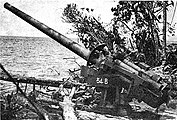14 cm/50 3rd Year Type naval gun (original) (raw)
From Wikipedia, the free encyclopedia
Naval gun
| 14 cm/50 3rd Year Type naval gun | |
|---|---|
 14 cm/50 3rd Year Type naval gun from the battleship Mutsu 14 cm/50 3rd Year Type naval gun from the battleship Mutsu |
|
| Type | Naval gunCoast-defense gun |
| Place of origin | Japan |
| Service history | |
| In service | 1914–1945 |
| Used by |  Imperial Japanese Navy Imperial Japanese Navy |
| Wars | World War I World War II |
| Specifications | |
| Mass | 5,600–5,700 kilograms (12,346–12,566 lb) |
| Barrel length | 7.0 meters (23 ft 0 in) (bore length) |
| Shell | separate-loading, bagged charge |
| Shell weight | 38 kilograms (84 lb) |
| Caliber | 14 centimeters (5.5 in) |
| Breech | Welin breech block |
| Elevation | -7° to +35° depending on mount[1] |
| Rate of fire | About 6 rounds per minute |
| Muzzle velocity | 850–855 meters per second (2,790–2,810 ft/s) |
| Maximum firing range | 19,750 meters (21,600 yd) at +35°[1] |
The 14 cm/50 3rd Year Type naval gun was a Japanese low-angle weapon introduced during World War I.
It served as the secondary armament in a number of Japanese dreadnoughts and as the main armament in light cruisers and some auxiliary ships. It was also the most common Japanese coast-defense gun during World War II. "Third year type" refers to the Welin breech block on this gun. Breech-block design began in 1914, the third year of the Taishō period. This breech-block design was also used on Japanese 40 cm (16 inch), 20 cm (8 inch), 15.5 cm (6 inch), 12.7 cm (5 inch), and 12 cm (4.7 inch) naval guns.[2]
This gun was not mounted aboard submarines. Submarine cruisers used the shorter-barreled 14 cm/40 11th Year Type naval gun.[3]
- single casemate mounts
- 20x1 _Ise_-class battleship (removed during conversion to hybrid carrier)
- 20x1 _Nagato_-class battleship
- single pedestal mounts
- 7x1 _Sendai_-class cruiser
- 7x1 _Nagara_-class cruiser
- 7x1 _Kuma_-class cruiser
- 4x1 _Tenryū_-class cruiser
- 2x1 light cruiser Yūbari (also had twin mounts)
- 4x1 aircraft carrier Hōshō
- twin mounts
- 3x2 seaplane carrier Nisshin
- 2x2 _Jingei_-class submarine tender
- 2x2 _Katori_-class cruiser
- 2x2 minelayer Okinoshima
- 2x2 light cruiser Yūbari (also had single mounts)
- (uncertain mount)
Weapons of comparable role, performance and era
[edit]
- BL 5.5 inch Mark I naval gun : British equivalent
- Canon de 138 mm Modèle 1910 Naval gun : French equivalent

A 3rd Year Type gun used for coastal defense.
A captured gun after the Battle of Enogai.
A turret mounted gun captured on Tarawa.
One of the three surviving Piti Guns on Guam.
- Campbell, John (1985). Naval Weapons of World War Two. Annapolis, Maryland: Naval Institute Press. ISBN 0-87021-459-4.
- Friedman, Norman (2011). Naval Weapons of World War One: Guns, Torpedoes, Mines and ASW Weapons of All Nations; An Illustrated Directory. Barnsley, UK: Seaforth Publishing. ISBN 978-1-84832-100-7.
- 14 cm/50 3rd Year Type on navweaps.com
